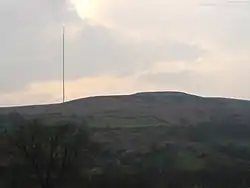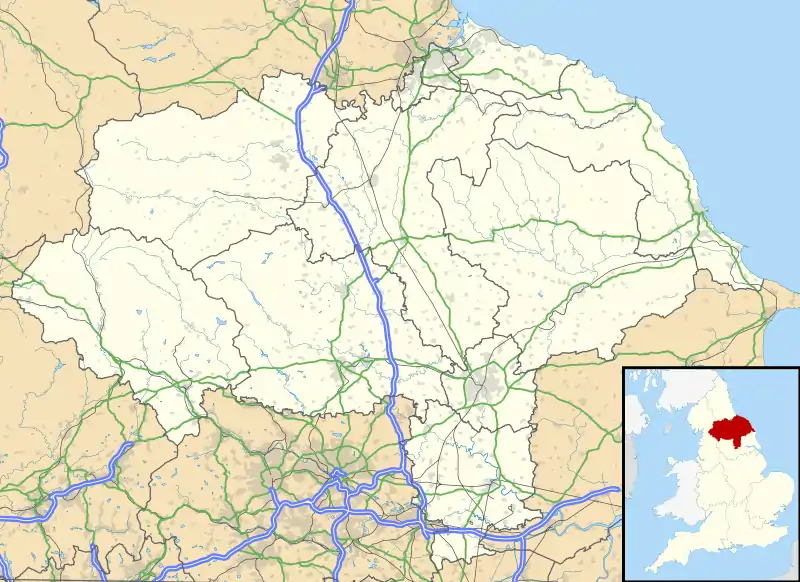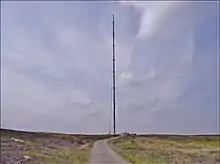Bilsdale transmitting station
The Bilsdale transmitting station is a broadcasting and telecommunications facility, located at Bilsdale West Moor above Bilsdale, close to Helmsley, North Yorkshire, England. It includes a guyed steel tubular mast that is primarily used for radio and television transmission. The height of the mast is 314 metres (1,030 ft) to the pinnacle.[2] It is among the most powerful in the UK, for analogue it was 500 kW ERP and is now 100 kW / 50 kW for digital. It has recently been equipped with new aircraft warning lights, in the form of arrays of ultra bright red LEDs.
 The Bilsdale mast stands high above the hills of the North York Moors. | |
 Bilsdale transmitting station (North Yorkshire) | |
| Mast height | 314 metres (1,030 ft) |
|---|---|
| Coordinates | 54.358611°N 1.150278°W |
| Grid reference | SE553962 |
| Built | 1969[1] |
| BBC region | BBC North East and Cumbria |
| ITV region | ITV Tyne Tees |
| Local TV service | Made In Teesside, That's York |

History
Bilsdale was constructed in 1969[3] by the BBC to bring 625-line colour television on UHF to Teesside and the surrounding areas for the first time. Having added UHF TV to the existing VHF TV stations at Pontop Pike and Emley Moor, it was quickly established that a new station would be required to cover County Durham and north North Yorkshire where existing coverage was poor, and thus the new station was built.
Construction
It was built by J. L. Eve Construction.
Coverage
Coverage extends throughout Teesside and the surrounding regions, encompassing north North Yorkshire and southern County Durham. This includes Harrogate and York to the south, Filey and Whitby to the east, Middlesbrough, Stockton, Darlington, Bishop Auckland, Hartlepool, Peterlee, some areas of Seaham and some areas of Sunderland to the north, and Barnard Castle and Worton to the west.
Channels listed by frequency
Analogue radio
| Frequency | kW | Service |
|---|---|---|
| 89.0 MHz | 5 | BBC Radio 2 |
| 91.2 MHz | 5 | BBC Radio 3 |
| 93.4 MHz | 5 | BBC Radio 4 |
| 95.0 MHz | 10 | BBC Tees |
| 96.6 MHz | 8.9 | TFM |
| 98.6 MHz | 5 | BBC Radio 1 |
| 100.7 MHz | 8.9 | Heart North East |
| 101.6 MHz | 1 | Classic FM |
| 106.4 MHz | 8.9 | Capital FM |
Digital radio
| Frequency | Block | kW[4] | Operator |
|---|---|---|---|
| 213.360 MHz | 10C | 10 | MuxCo North Yorkshire |
| 222.064 MHz | 11D | 4.7 | Digital One |
| 223.936 MHz | 12A | 2 | BBC National DAB |
Digital television
In July 2007, it was confirmed by Ofcom that the television frequency assignment after digital switchover would be such that a wideband or group K aerial would be required for reception of all six multiplexes. However, the three public service multiplexes would still fall within the station's original analogue frequency range assignment of aerial group A.[5] The digital switchover started at Bilsdale on 12 September 2012 and was one of the last transmitters in England to complete this operation on 26 September 2012, the others being Pontop Pike and Chatton in the same region.[6]
On 13 November 2019, due to the 700 MHz Clearance Programme, the following multiplexes moved frequencies:
- BBC A from UHF 26 to UHF 21.
- Digital 3&4 from UHF 29 to UHF 24.
- BBC B from UHF 23 to UHF 27.
- Arqiva C and D moving to UHF 55 and UHF 56 respectively.
On 12 March, BBC A and BBC B swap UHF Channel allocations, with BBC A on UHF 27 and BBC B on UHF 21.
On 25 June 2020, COM 8 was switched off permananetly due to the effects of the 700 MHz clearance programme.
| Frequency | UHF | kW | Operator | System |
|---|---|---|---|---|
| 474.000 MHz | 21 | 100 | BBC B | DVB-T2 |
| 498.000 MHz | 24 | 100 | Digital 3&4 | DVB-T |
| 522.000 MHz | 27 | 100 | BBC A | DVB-T |
| 626.000 MHz | 40 | 50 | Arqiva B | DVB-T |
| 650.000 MHz | 43 | 50 | SDN | DVB-T |
| 674.000 MHz | 46 | 50 | Arqiva A | DVB-T |
| 746.000 MHz | 55 | 26.9 | Arqiva C | DVB-T2 |
Before switchover
| Frequency | UHF | kW[7] | Operator |
|---|---|---|---|
| 474.000 MHz | 21 | 6 | Digital 3&4 (Mux 2) |
| 498.000 MHz | 24 | 6 | BBC (Mux B) |
| 522.000 MHz | 27 | 6 | Arqiva (Mux C) |
| 554.000 MHz | 31 | 6 | SDN (Mux A) |
| 578.000 MHz | 34 | 4.8 | BBC (Mux 1) |
| 642.000 MHz | 42 | 1.6 | Arqiva (Mux D) |
Analogue television
Analogue television is no longer available from Bilsdale; BBC Two was closed on 12 September 2012, followed by the remaining four channels on 26 September 2012.
| Frequency | UHF | kW | Service |
|---|---|---|---|
| 487.25 MHz | 23 | 500 | Channel 4 |
| 511.25 MHz | 26 | 500 | BBC Two |
| 535.25 MHz | 29 | 500 | ITV1 (Tyne Tees regional feed) |
| 567.25 MHz | 33 | 500 | BBC One |
| 583.25 MHz | 35 | 500 | Channel 5 |
Relays
Below is a list of transmitters that relay Bilsdale.
Digital television
| transmitter | kW | BBC-A | BBC-B | D3&4 | SDN | ARQ-A | ARQ-B | Pol. |
|---|---|---|---|---|---|---|---|---|
| Aislaby | 0.0076 | 45 | 42 | 39 | N/A | N/A | N/A | BV |
| Bainbridge | 0.0076 | 57 | 53 | 60 | N/A | N/A | N/A | CDV |
| Castleton | 0.002 | 50 | 55 | 59 | N/A | N/A | N/A | CDV |
| Eston Nab | 0.003 | 52 | 48 | 51 | N/A | N/A | N/A | BV |
| Grinton Lodge | 0.005 | 45 | 49 | 42 | N/A | N/A | N/A | BV |
| Guisborough | 0.01 | 57 | 53 | 60 | N/A | N/A | N/A | CDV |
| Limber Hill | 0.008 | 47 | 44 | 41 | N/A | N/A | N/A | BV |
| Peterlee | 0.002 | 45 | 39 | 42 | N/A | N/A | N/A | BV |
| Ravenscar | 0.033 | 56 | 53 | 58 | N/A | N/A | N/A | CDV |
| Romaldkirk | 0.012 | 44 | 47 | 41 | N/A | N/A | N/A | BV |
| Rookhope | 0.002 | 45 | 49 | 42 | N/A | N/A | N/A | BV |
| Rosedale Abbey | 0.002 | 45 | 42 | 39 | N/A | N/A | N/A | BV |
| Skinningrove | 0.006 | 52 | 48 | 51 | N/A | N/A | N/A | BV |
| West Burton | 0.002 | 45 | 42 | 39 | N/A | N/A | N/A | BV |
| Whitby | 0.1 | 55 | 50 | 59 | N/A | N/A | N/A | CDV |
See also
References
- "Bilsdale Transmitter". ATV aerial sales. Retrieved 23 December 2015.
- http://www.muxco.com/docs/muxco-yorks.pdf MuxCo Ofcom DAB application document
- "The Big Tower Bilsdale". The Big Tower. Retrieved 23 December 2015.
- Radio Listeners Guide 2010
- "Archived copy" (PDF). Archived from the original (PDF) on 13 October 2008. Retrieved 27 April 2008.CS1 maint: archived copy as title (link) Ofcom digital switchover plan
- "Digital UK – Tyne Tees region". Archived from the original on 18 October 2012. Retrieved 11 August 2012.
- Television Viewers Guide 2009